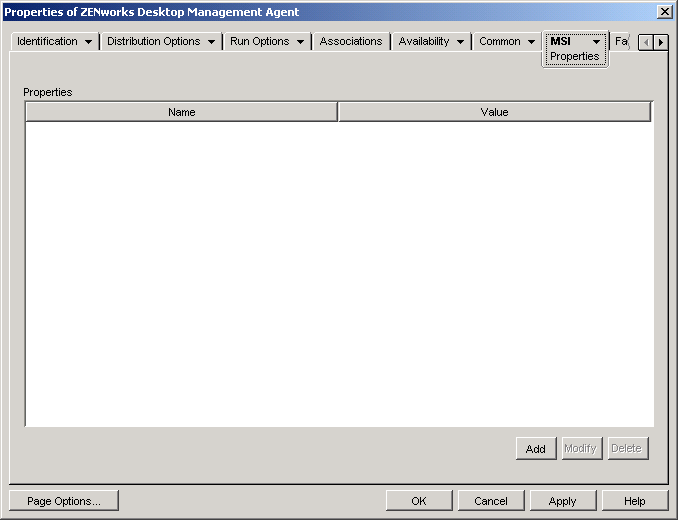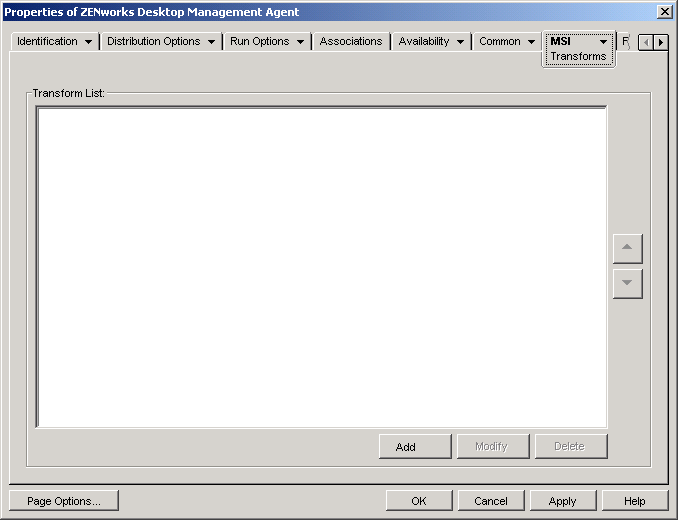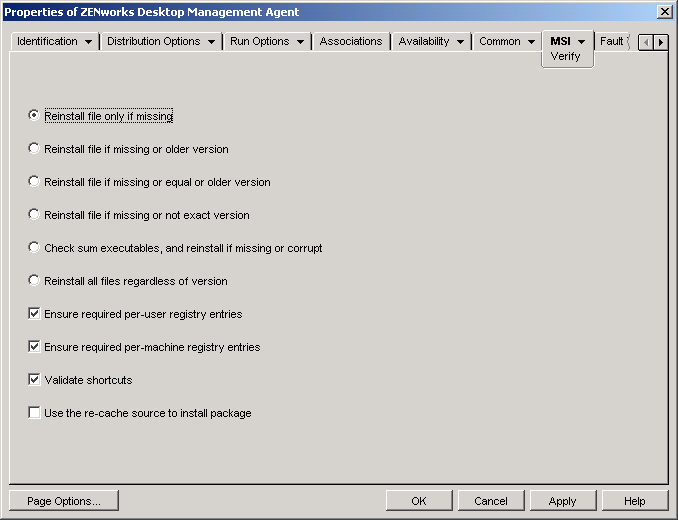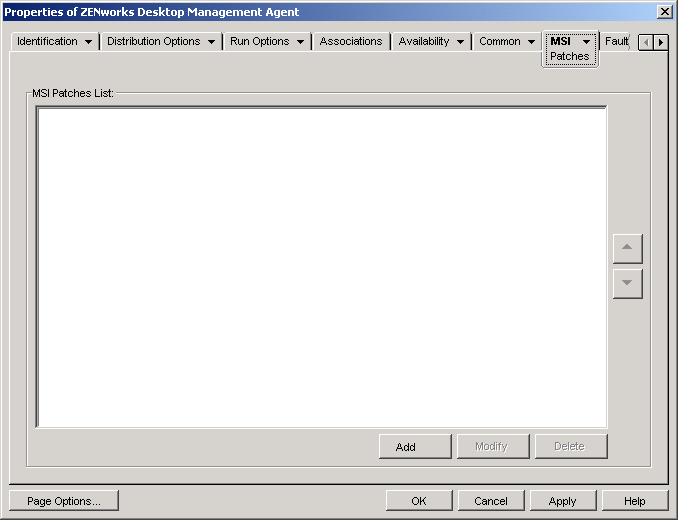48.7 MSI Tab
The MSI tab is available only on Application objects created for MSI applications.
The MSI tab includes the following pages to help you configure and manage the distribution of MSI applications installed through the Microsoft Windows Installer:
48.7.1 Properties Page
The Properties property page, shown below, lets you override the public property values contained in the MSI package and add new public properties.
Figure 48-51 Application Object > MSI Tab > Properties Page

The MSI package contains the property values that were defined during the administrative installation of the application. These property values determine the way the Microsoft Windows Installer installs the application to the user’s workstation. In some cases, you might want to change one or more of the property values. For example, a property value might define the default location for a user’s work files. By adding the property to the Properties list and changing the property’s value, you can override the default location defined in the MSI package.
If necessary, you can add public properties that were not included in the MSI package. When doing so, you should be careful to add only those properties that are valid for the package.
Add
To override a property value, you change the property value and add the property to the list so that Application Launcher knows to use that property value rather than the one defined in the MSI package. To do so, click to display the Select Property to Add dialog box. In the field, select the property whose value you want to override, specify the new value in the field, then click to add the property to the list.
To define a new property that is not already included in the MSI package, click to display the Select Property to Add dialog box. In the field, specify the new property’s name, enter the property’s value in the field, then click to add the property to the list.
For a list of properties and descriptions, see the Microsoft Developer Network (MSDN).
Although you can add and define new properties, the property is reserved for Application Launcher use.
NOTE:When Application Management distributes and installs an MSI application, it uses the AlwaysInstallElevated policy, which installs the MSI application using elevated (system) privileges. Because of this, in order to set the property value to null so that the application is installed on a per-user basis, you need to leave the field empty. Using double quotation marks (““) causes the distribution to fail.
Modify
To modify a property that is in the list, select the property, click to display the Edit String Value dialog box, modify the value data, then click .
Delete
To delete a property from the Properties list, select the property, then click . Deleting the property causes future installations of the application to use the property value defined in the MSI package.
48.7.2 Transforms Page
The Transforms property page, shown below, lists the transforms that Microsoft Windows Installer applies to the MSI package during distribution. A transform adds, deletes, or changes properties in the MSI package to enable customizing of the installation for different groups of users.
Figure 48-52 Application Object > MSI Tab > Transforms Page

Transforms are applied in the order they appear in the List. If two transforms modify the same package property, the property retains the value applied by the last transform.
For information about creating transforms for your MSI package, see the documentation you received with the software application.
Add
Click , browse to and select the transform file (.mst file) you want added to the list, then click to add it to the list. If the transform file is in the same directory as the .msi file, you must simply enter the filename in the field rather than browsing to and selecting it. If you provide the complete filepath, then the transforms are unnecessarily downloaded twice resulting in high network bandwidth utilization.
If you select the file, make sure that the resulting path is either a UNC path or mapped path common to all users.
Delete
Select a transform from the , then click to remove it from the list.
Up-Arrow and Down-Arrow
Select a transform from the , then click the up-arrow to move the transform up in the list or click the down-arrow to move it down in the list. Microsoft Windows Installer applies the transforms in the order they are listed, from top to bottom.
48.7.3 Verify Page
The Verify property page, shown below, determines the actions that Microsoft Windows Installer takes when instructed to verify the application.
Figure 48-53 Application Object > MSI Tab > Verify Page

When a user verifies the MSI application, Application Launcher launches Windows Installer. If no options are selected, Windows Installer performs a full verification, which results in all files, settings, and so forth being reinstalled. If one or more options are selected, Windows Installer only performs the actions specified by the selected options.
The reinstall options are mutually exclusive, meaning that you can only select one of the options. The remaining four options are independent of one another: some, all, or none can be selected.
Reinstall File Only if Missing
Instructs Windows Installer to reinstall a file only if it is missing.
Reinstall File if Missing or Older Version
Instructs Windows Installer to reinstall a file if it is missing or if the installed file’s version is older than the file in the MSI package.
Reinstall File if Missing or Equal or Older Version
Instructs Windows Installer to reinstall a file if it is missing or if the installed file’s version is the same as or older than the file in the MSI package.
Reinstall File if Missing or Not Exact Version
Instructs Windows Installer to reinstall a file if it is missing or if the installed file’s version is not exactly the same as the file in the MSI package.
Check Sum Executables, and Reinstall if Missing or Corrupt
Instructs Windows Installer to perform a checksum on all executable files and to reinstall a file if it is missing or if the checksum verifies that the file is corrupt. Only files that have msidbFileAttributesChecksum in the column of the MSI package’s File Table are repaired.
Reinstall All Files Regardless of Version
Instructs Windows Installer to reinstall all files.
Ensure Required Per-User Registry Entries
Instructs Windows Installer to rewrite all per-user entries from the MSI package to the Windows system registry. Per-user entries are those entries contained in the HKEY_CURRENT_USER and HKEY_USERS registry hives.
Ensure Required Per-Machine Registry Entries
Instructs Windows Installer to rewrite all per-machine entries from the MSI package to the Windows system registry. Per-machine entries are those entries contained in the HKEY_LOCAL_MACHINE and HKEY_CLASSES_ROOT registry hives.
Validate Shortcuts
Instructs Windows Installer to reinstall the MSI application’s shortcuts, overwriting any existing shortcuts and icons.
Use the Re-Cache Source to Install Package
Instructs Windows Installer to install files from the re-cache (local) source rather than the source package.
48.7.4 Patches Page
The Patches property page, shown below, lists the patch files that Microsoft Windows Installer applies to the MSI package during distribution. Each patch is applied in the order listed in the MSI Patches List.
Figure 48-54 Application Object > MSI Tab > Patches Page

Add
Click , browse to and select the patch file (.msp file or other MSI-based patch file) you want added to the MSI Patches List, then click to add it to the list. If the patch file is in the same directory as the .msi file, you can simply enter the filename in the MSI Patch File field rather than browsing to and selecting it. If you provide the complete filepath, then the patches are unnecessarily downloaded twice resulting in high network bandwidth utilization.
If you select the file, make sure that the resulting path is either a UNC path or mapped path that is common to all users.
Modify
Select a patch from the list, then click to edit the location of the patch.
Delete
Select a patch from the list, then click Delete to remove it from the list.
Up-Arrow and Down-Arrow
Select a patch from the MSI Patches List, then click the up-arrow to move the patch up in the list or click the down-arrow to move it down in the list. Microsoft Windows Installer applies the patches in the order they are listed, from top to bottom.